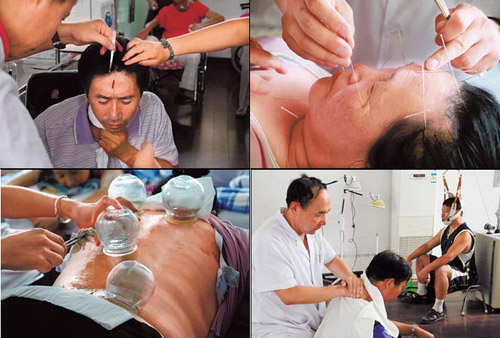hotrecommend
Mongolian medicine recovers
By Cao Li (China Daily)
Updated: 2010-08-25 09:11
 |
Large Medium Small |
|
 Traditional Mongolian medicine remedies, such as blood treatment, cupping, acupuncture and massage have regained popularity in recent years, something the regional government is keen to capitalize on. Photos by Wu Yunsheng / For China Daily Related video:Mongolian medicine recovers |
Mida no longer herds sheep and cattle on sprawling grasslands; that part of her once-nomadic life is firmly in the past.
Yet, two things will remain the same forever: The recurring pain in her leg and the ancient Mongolian therapy she uses to soothe it.
After lighting a small piece of paper, the 57-year-old placed it in a tea cup and attached it to her left knee.
"It really works for my rheumatoid arthritis," said Mida, who like most ethnic Mongolians uses only her given name. "I only need to do it once a year when the grass seeds germinate in spring."
Mida explained that the traditional treatment had been passed down to her from her mother, who in turn had learned it from her own mother.
"Once upon a time, when medical services were not so easily available, the herdsmen had to be able to cure themselves," she said, smiling.
The flaming tea cup is arguably one of the milder treatments. Other traditional remedies include cutting open fingers to cure intestinal and stomach ailments caused by the summer heat, rubbing white liquor on the breast, back and underarms to cure a fever, and putting fresh sheep innards on the stomach.
"My mother used to always boil raisins, sweet jujube and rock sugar to cure a cold," said Mida, who was 14 when she started shepherding livestock between Hohhot and Baotou in the Inner Mongolia autonomous region.
She and her 62-year-old husband, Huarihu, retired seven years ago when authorities ordered the suspension of grazing on an area of more than 87 million hectares by the end of 2009, part of a nationwide campaign to restore the vegetation on grasslands. The couple is among 400,000 former nomadic herders who have since resettled in towns and cities.
They now live in a home shaped like a traditional Mongolian yurt (a large tent) and rent most of the 90 hectares they were allocated by the government to tourist companies.
Although Mida is holding true to her ancestors' healthcare rituals, some of which have lasted for more than 2,000 years, she knows these ancient ways are in danger of dying out. All of her three children, one of whom lives in Shanghai, know little about her remedies, she said.
